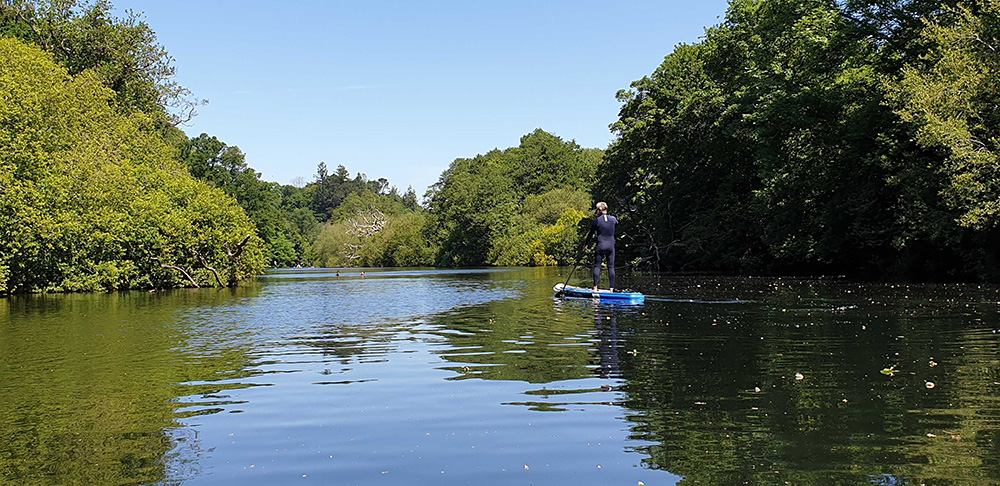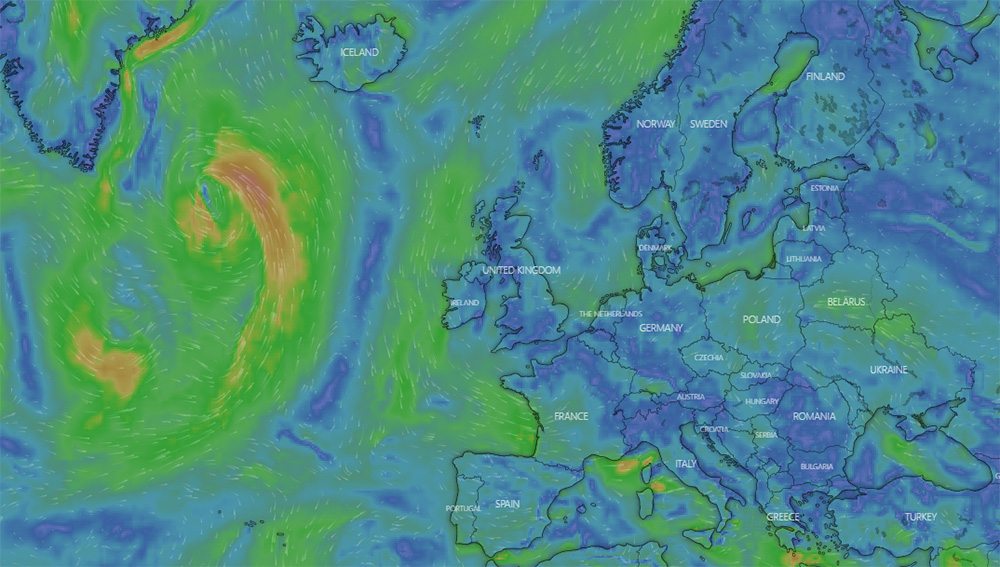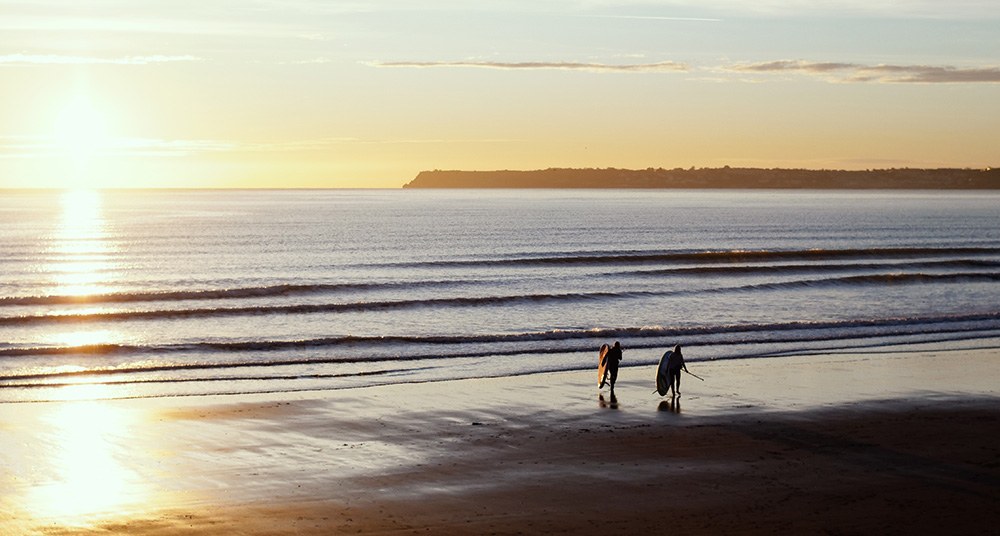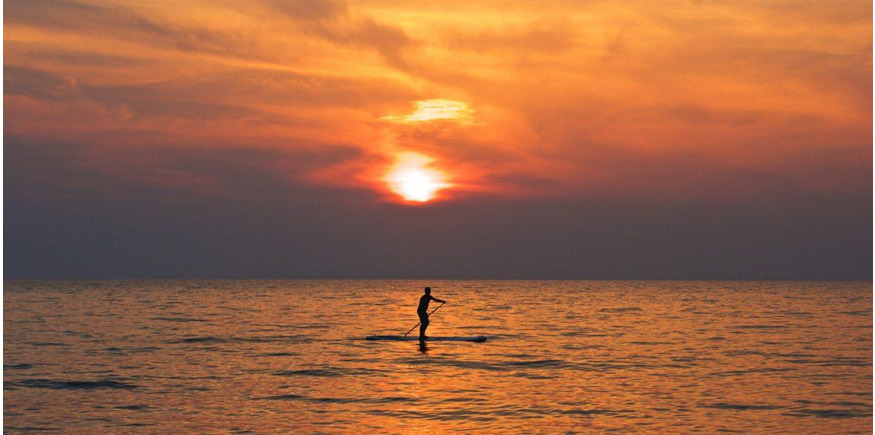All kinds of weather conditions are suited to paddleboarding. However, different conditions suit paddlers of different levels of experience. As a beginner, it’s important to learn how weather can affect a day out on the water. But it’s important that all paddlers check on weather conditions and forecasts before launching.
Taking a SUP to calm waters
Flat water is as good as it gets for beginner paddlers (and anyone who just wants a relaxing cruise). This only occurs in the ocean when there’s very little wind and no swell in that area, or if you’ve found a spot that’s particularly sheltered.
Calm conditions are great for beginner paddlers looking to get used to their boards and balance points without the hazards presented by choppy seas.
Anyone looking to practise SUP yoga will also hugely benefit from a calm day. You’ll find it difficult to hold a pose while being knocked around by lumpy water!
If you struggle to find calm seas because the coastline is particularly exposed, we recommend looking for lakes, canals and slow-running sections of river.

How wind speed and direction affects paddleboards
Wind is one of the most important things you can pay attention to when paddleboarding. Strong winds from any direction make your life difficult. If you are a beginner, we recommend sticking to days with minimal wind.
Offshore winds are particularly dangerous. This is when the wind is blowing directly out to sea. At any reasonable speed, it will be difficult to paddle against the wind, if not impossible. You may find yourself taken further from the shore than you are comfortable with.
An onshore day (when the wind is blowing directly at the shore) can also be problematic. You may find it difficult to paddle anywhere at all if you are constantly pushed back towards your launch spot.
If the wind is blowing cross-shore, you could end up being pushed one way down the coast but then struggle to make the return trip if you plan on landing at your original launch spot.

Use an app like windy.com to determine the conditions for the duration of your paddle
For more experienced, confident and physically fit paddlers, wind can sometimes be beneficial. Some paddlers like to downwind SUP: using a combination of wind and swell in open ocean to glide and travel further at higher speeds. These are usually one-way trips.
Be realistic about your ability in these conditions and check wind forecasts before heading out. Conditions change suddenly at sea, so it’s always a good idea to be prepared.
Choose appropriate clothing for the weather
Even in the British summer, a wetsuit can seem like overkill unless you plan on being in the water a lot. But during the depths of winter, a basic wetsuit is essential.
You can easily check the water temperature for the area where you plan to paddle, so consider the likely scenario: will you be in and out of the water a lot or staying dry? Could that decision be taken out of your hands by your ability or difficult conditions?
When thinking about water temperature and what to wear, it’s also important to consider the wind. Even on a sunny day, when the water’s warm, it can feel much colder when an onshore breeze is blowing. If there is no wind, you may find yourself getting hot while paddling.
We recommend taking a dry bag with additional clothing options if you plan on being out for a long time.
Tides, currents and paddling ability
Tides and currents may be a little off track when thinking about weather conditions, but from a safety point of view you will need to be wary of them when paddleboarding.
Tides are especially important to consider when paddling on tidal river sections. If you are planning a downriver paddle, make sure you do so at slack tide or during an outgoing tide. You don’t want to battle an incoming tide; paddling against all the water rushing back in will be a challenge. If you are paddling upriver, make sure it’s not during an outgoing tide.

Depending on the section of river and average water levels (which can change depending on rainfall) it’s usually a good idea to paddle closer to high tide than low tide. Low tides could potentially expose shallow sections of river which you cannot paddle on and may damage your board. If you regularly paddle in the same area, you’ll get to know when a good time is.
With currents, you will only really get to know these with experience. You may benefit from speaking to locals who know the area. They could provide you with advice on where to avoid and how to navigate certain areas.
SUP surfing conditions
If you want to catch waves on your SUP, it’s worth learning about surf forecasting so you can learn how swell height affects wave heights at certain spots. This way, you can know in advance whether waves are within or beyond your limits. Again, speaking with locals or experienced surfers may help you to understand where to go and what conditions are suitable.
The best advice we can give is to make sure you regularly check weather apps and surf forecasting apps so you can make informed decisions. Always be prepared for any changes in weather that may occur.
Want to discover more useful tips to help improve your SUP boarding experience? Check out some of our other blog posts for further paddling reflections and advice.




